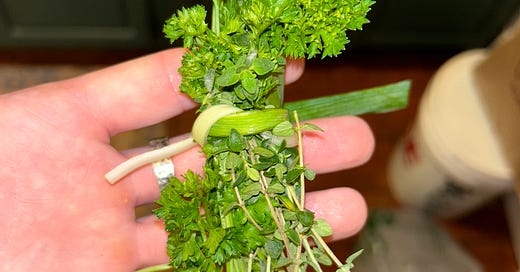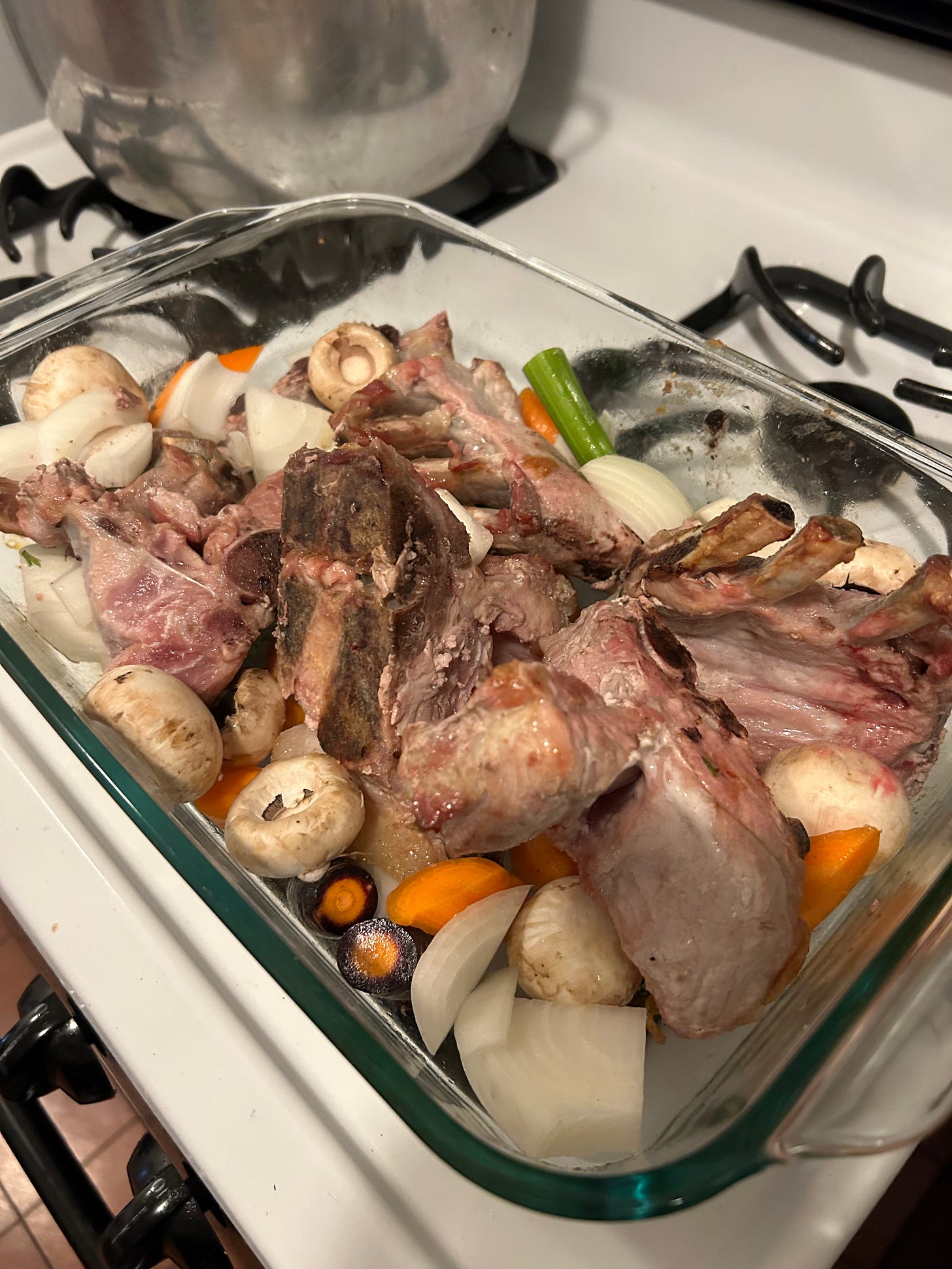There are many headnotes above Robuchon’s recipes in which he gives context to the recipe’s origin, instructions for how to speak to butchers, nostalgic notes of the recipe’s importance, etc. They add charm and insight to the ways we are to think about each recipe. For Brown Veal Stock (Fond brun de veau), his headnote begins:
This is indisputably the essential sauce base in classic French cuisine.
And, at least in regards to his own collection of recipes, this appears to be true. If he calls for a sauce to be made, it undoubtedly also calls for about a 1/2 L of Brown Veal Stock as its base.
I cracked my book open and–after reading a rather long 32 page introduction listing the materials required for the book’s recipes (tons of things which I do not have and will be scouring second hand markets for)–I turned to page 37, topped by a list of ingredients beginning with “2 pounds of veal bones, coarsely chopped”. I have never purchased a veal bone. Nor any bones for that matter. I have lived life blissfully in the ignorance of stock-making and its boney pursuits.
In my wonderings of how to fetch veal bones, I had romanticized visions of a butcher shop who would have every oddity I sought. One who had veteran butchers saying things like “we just got that gallon of boar’s blood you were looking for” as they passed me a plain brown bag.
In horrific surprise, this meaty butchery heaven was a tougher find than I thought. Can you believe it? Real life is not a Julia Child montage? Sad. But, after visiting an onslaught of uninteresting and florescently-lit meat counters I strolled into Ver Brugge. You are greeted only by an endlessly long meat counter and the group of old men who have been stocking it for decades. They had the bones for which I searched! They had a selection of blood and bits for which my future recipes called! The journey through Robuchon felt doable only after meeting these meat mongers.
Once my ingredients were tracked down I felt a miserable sense of having forgotten an item. Surely the “essential sauce base” in French cuisine must be more complicated than some bones and easily found vegetables boiled in water? Checking the ingredient list again and again, I finally stifled the forgetful feeling and began.
I had a few questions from the start:
1) Robuchon makes no suggestion of a specific type of mushroom to use in this stock. He asks for “1/4 mushrooms, trimmed and cleaned”. Is he assuming I have knowledge of a standard stock mushroom? Are the differences in flavor between the common mushrooms so subtle that it will not matter? I can’t imagine this to be the case. A White Button versus a Chanterelle versus a Morel would all have significant flavor differences. So, I am still wondering if there is a better mushroom which I could have / should have used. In this instance I used White Button mushrooms.
2) We are asked to make a “Bouquet Garni” — a standard term for herbs tied together and thrown into a pot usually of stock. However, Robuchon only mentions which herbs should be included and does not give quantities of each herb. I wonder still if my quantity was either too little, too much, or just right. A Goldilocks qualm. Regardless, I was happy to practice my leek knots! Here is a picture of my first Robuchonian Bouquet Garni:
After my ingredients were prepped, and my bouquet tied, I began the careful roasting of the veal and pork bones in the oven before setting them into a pot to boil away for the afternoon.
While the bones and vegetables took their boiling bath, I was surprised again by the simple but careful steps to make this stock. This is not a passive pursuit of throwing items into water and letting them boil for hours. Robuchon requires a careful “skim and degrease” of the stock each half hour, for four hours. “Degreasing”—a technique I did not yet have experience with—consists of slowly pouring cold water over the boiling stock so the fat rises and is able to be removed. You are not allowed to throw the pot on the stove and head out to run errands. The recipe requires a halting. A relieving of our tapped-in minds. A pause of the cramming of life. Why not sit near a stock for 4 hours of the afternoon? I imagine that—in addition to its added benefit to the stock’s quality—Robuchon was skimming and degreasing because he could not help but carefully tend to his creation as it bubbled away. Simple and whole ingredients are reminders of our most human bits, how we are connected to the land, and how we share its bounty. I chose to use the 30-minute intervals to pause, breathe in the wonderful scents, and tidy the kitchen.
While I cleaned between the skims and degreases, the aroma wafting through my apartment was powerful and anachronistic. Shimmering up and out of the stockpot was the smell of small homes and corner gardens. Of large old pots put to boil by providers and carers. I was reminded of my mother, who lives over 2000 miles from me. Of how she raised and nourished our family by the things which wafted from her large old stockpot. Reminded of her mother whom I never met, and of how she must have raised her family in the same fashion. Reminded of the ones before them, how they found themselves in binds to survive—and how they found their survival in food. These are the memories of an ancient lineage of cooks, of fellowship, and of caretakers.
Thank you for caring about food. Thank you for reading.
“Cooking is the creation of emotion” - Joël Robuchon
Now, a few technical things I wonder about this recipe:
Robuchon says that we will end up with 1 L of stock at the end, however, I ended up with just under 1/2 L. I am not sure if this is due to my inability to skim the stock properly? I may be removing too much liquid as I skim the foam which boils to the top. Anyway, as it stands, I will have to make quite a few rounds of this recipe if I want to make my way through the book.
The bones were frozen when I began roasting them in the oven. Should I let bones thaw? Is that counterintuitive? Do frozen bones vs thawed bones make a difference at the beginnings of a recipe?







